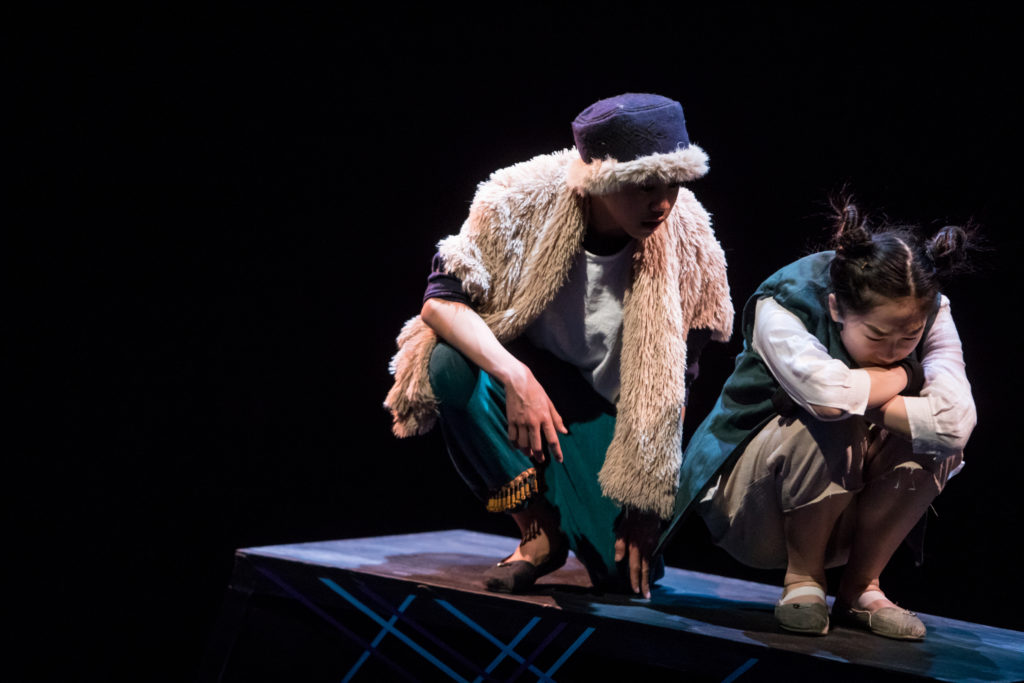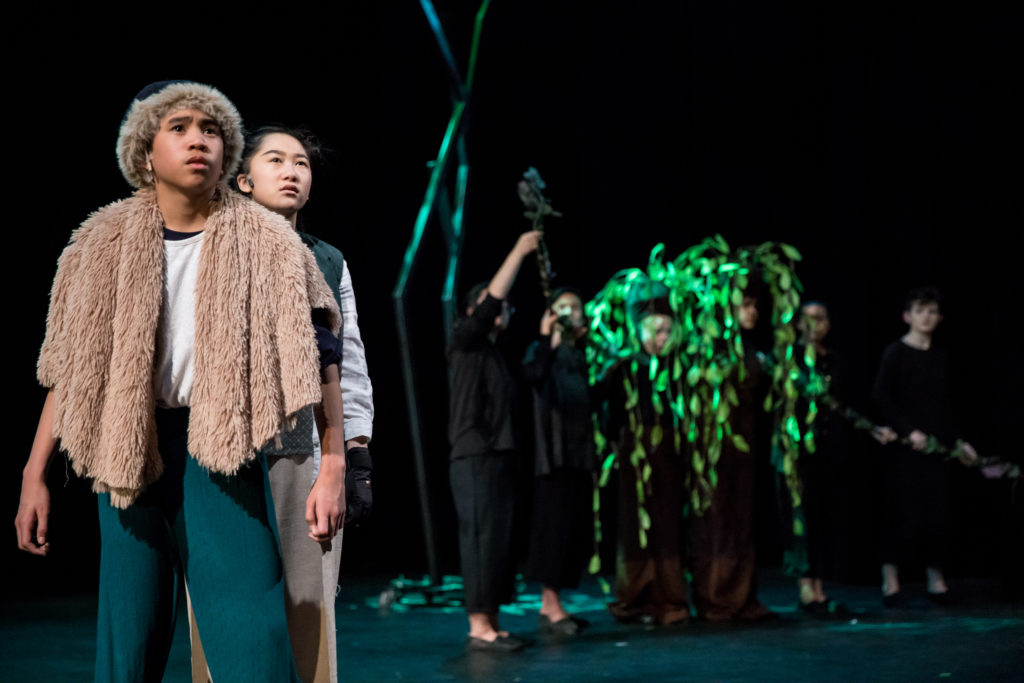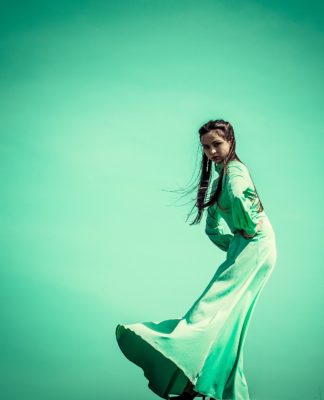The more we learn about how trauma affects children, both in the immediate and as they grow up and grow older, the more important it becomes to understand how to address this trauma; how we can find a path through darkness that defines the lives of so many.
Bullying. Eating disorders. Depression. Suicide rates on the rise. This is not an abstract problem. It’s a real, day-to-day problem. And one with dire consequences.
But when a subject is too sharp, we often use art to soften the blow – to illustrate the problem, and how we might address it, without triggering further trauma or pushing victims away. It can (when successful) translate personal struggle and pain into something universal, and let an audience, an individual, an innocent know that they are not alone.
The Last Firefly, a play written by Naomi Iizuka and presented as a collaborative effort between mainstay St. Paul theater companies, Theater Mu and SteppingStone, hopes to do exactly that.

The play
But the play is not just about the terrible things life far-too-often throws at youth and adults alike. Not only. And not even mostly. Because, especially in the current social climate, in the wake of fallen heroes like those of Leaving Neverland and the #MeToo movement, it’s also about finding the inner strength that allows us to overcome these trials and find a better way forward; the things that help us become the people we were always meant to be in spite of them.
“It’s a parable for how to develop internal strength – find the thunder within ourselves,” director Daisuke Kawachi says. “And help others find that strength as well.”
As we sit at the Guthrie Theater in Minneapolis (where Kawachi is also working on upcoming Stories from the Drum), overlooking the Stone Arch Bridge and the slow drip of melting snow outside, he is relaxed, calm, at-ease. This is his world. One of costumes and stories and greater truths playing out onstage – though his excitement in discussing his first time in the director’s chair is palpable as well.
“It’s a metatheatrical experience,” Kawachi says, sitting closer. A play-within-a-play. We’re watching a child search for her father, after facing real abuse at the start of the play.
(Briefly: Following abuse by her stepfather, Boom, the child of Thunder, flees home and embarks on a journey to find her real father, traveling through unfamiliar lands, and facing a myriad of trials and tribulations along the way, each one more fantastic than the last.)
The director’s excitement also stems from the brilliance of theater in general: translating one person’s story (Iizuka’s), through the mind of the director (Kawachi), to then be processed by the audience – each with their own interpretations, and their own personal struggles and strength. This is the power of theater.
And perhaps it’s even more than that.
As was mentioned in the lede, it’s important to find new (better) ways to talk about these things; bring darkness into light in ways that look, feel, sound just a little bit better; that are easier to swallow, digest, process. More importantly, to remind us the world is also about adventure, discovery, and joy – that is, the world does not lose its light simply because of there is darkness in it as well.
“There are plenty of easter eggs for the audience to find,” Kawachi says. “For example, Boom picks up something new from each battle she fights that helps her in the next one… and each piece comes together at the end, synergizing for the final battle.”
Which is sure to excite anyone familiar with culture of superheroes; growing up in a world of ultimate boss battles, leveling up, and final forms.
“Something that is easy to forget is that everything onstage is intentional… everything that we do, down to the last step, is deliberate. And the play truly is the sum of its parts.”

The Last Firefly (again)
You might remember the last time The Last Firefly was on a Twin Cities stage: The Children’s Theater put on the show in 2016, to great reviews and acclaim. Or maybe you missed it. Either way, this won’t be the same experience.
When Theater Mu’s Dandelion Girl was put on hold (“It needed more time to mature,” Kawachi explains, “to become the play it was always meant to be, instead of trying to force it”), a new staging of Firefly became the perfect solution.
“We have the same cast and most of the same crew…” Kawachi laughs, “And I’m still the same director.”
And this won’t be Kawachi’s first experience with Iizuka’s play either: He first encountered Firefly back in 2011, while still a theater major at Carleton College in Northfield. Though the actors were older (college-age), and both the stage on which it was presented, and the mission it hoped to achieve, were quite different as well.
Along with assistant director Sara Ochs (“I couldn’t do this without her,” Kawachi says), the idea this time was to develop a play that encompasses pressing issues of today, while honoring the rich tradition of folklore and fantasy of the Far East simultaneously. In this, the play has been updated, and creative changes have been made to reflect not only the younger demographic for whom the play is meant, but perhaps tell a story rooted more fully in the 2019 zeitgeist: A fantastical world that offers insight into how we might deal with the real one.
“The character of Boom has been updated as female,” Kawachi says. “There are still a disproportionate number of male-to-female heroes, especially in this sort of context. Boom as a girl also changes the nature of the relationships in the play. And the actors are a bit more age-appropriate as well.”
Representation is important – not only cultural representation (Theater Mu remains the only theater in Minnesota committed to the Asian-American experience, and the cast is predominantly Hmong), but also generational. SteppingStone Theatre is, as their tagline tells us “For Youth,” and youth will see themselves in the characters onstage. Adults feature minimally in the show.
“Children deserve to see themselves as heroes as well.”
Though it isn’t just a show for kids.
“I like to describe it as high and low,” Kawachi says with a smile. “Literally and figuratively. It will operate on levels both children and adults can appreciate. For people who are tall (high) and short (low).”

Tradition and future (on the stage)
The idea is also that this can’t (or shouldn’t) end on the stage; the purpose far greater than one-night-only entertainment finished when the curtain falls, left behind in applause. These are useful tools for how we might talk about abuse, connection, and, as Kawachi describes it, “finding the thunder within us all.”
It’s not a play that can ever truly be “finished,” but seen rather a story told over and over again. It’s returning to tradition while moving forward. It’s one food rooted in the past while the other kicks down the door of the future. For everyone and anyone.
Even director Kawachi himself, able to explore his own duality as Japanese-American through this work on the play. As he said recently in an interview with Twin Cities Arts,
As a Hapa person living in the U.S., I have a complicated relationship with Japanese culture which I can simultaneously claim and still be excluded from. In this play in particular, Naomi is playing with and remixing so many elements of Kabuki; what she has written gives me, as a director, so much freedom to work within the spirit of the Kabuki elements without trying to create traditionally and historically accurate replicas.
As a successful play is about everyone involved. Everyone’s stories, and what they bring to the table: While he might be the one pulling the strings, it’s the abilities of the actors onstage that the director is most excited about.
“The ensemble is incredible. The cast [of student actors] so dynamic. They’re all incredibly talented. And the choreography as well – the fight scenes will blow you away.”
And it’s about inclusion, in any/every/all facets of the play. The old theater adage of “There are no small parts…” applies in literal practice here.
“People with lines, people without lines,” Kawachi says. “Everyone involved is vital to the success of the play. And they know that. The takeaway is that everyone is important… even actors without lines can develop new skills, learn, and be a part of something exciting and new.”
While using the Kabuki practice of Kuroko to great effect – the stagehands are visible (but still “invisible” dressed all in black) and important, pieces of the stage: They hand props to actors. They become ghosts. They become elements. Clouds. Echoes. Waterfalls. Kawatchi had no interest in, as he says, “hiding bells and whistles” of the stage, rather enhancing the fact this is the stage, and the stage is a magical place.
“Though I should stress that this is not Kabuki. Not in the traditional sense.” Kawachi laughs. “I call it kabuki-inspired. Kabuki is an ancient tradition. Passed down generation to generation, and takes many years to achieve even basic proficiency. I would never claim we were doing traditional kabuki here. It’s simply drawing from, and inspired by, this tradition.”
Because, again, it’s about coming together – whether as individuals, or as a culture as-a-whole. Respecting and embracing differences enough to know that everyone is an “other” somewhere, and then bringing those differences together to create the ultimate East-meets-West experience.
As author Iizuka describes it,
“There are entrances, exits, quick changes, scene changes, mie or dramatic poses, fight sequences, aerial choreography, and moments of stage magic that were inspired by the conventions of Kabuki theatre. I am, however, an American playwright living in Southern California at the beginning of the 21st century. I am a product of many traditions. I am a member of many tribes. The traditions of Kabuki are meant to be a starting point. What happens next is up for grabs.”
While addressing core themes of trauma, memory, and finding strength to face any number of social issues youth are dealing with today (which we discuss in depth here: Blame it on my youth: The struggles of a coming generation). It becomes a perfect balance – the jubilance and joy of youth to help overcome dark days, and everything that we can do to help each other along the way.
“It’s important, crucial even, to figure out how to have these discussions now,” Kawachi says. “Children are, after all, the future. It’s about offering guidance, offering the right tools so we can move toward a world where suffering no longer exists as such.”
“It would be a disservice not to discuss these things. To not to engage our youth. Theater allows us to talk about ourselves without actually talking about ourselves…
“Our hope is that this [The Last Firefly] will translate far beyond the stage, through fantasy and imagination, into the real world.”
The play premiers this Friday, March 22, 2019, and runs through April 7, 2019. Get your tickets by clicking here.

OFFICIAL SYNOPSIS
It begins with light, a sliver, a flash, then comes a sound, a pulse, a beat, a crash like a giant hammer smashing through the sky. Thus, the story of Boom, the son of Thunder, begins as he sets out on an epic search for his father, ultimately discovering his true self and the strength within him that always existed. This mythical adventure will transport you and your child on a fantastic journey where the littlest things can make all the difference in the world.
PUBLIC PERFORMANCES
March 22: 7:00 PM
March 23 : 3:00 PM
March 24: 3:00 PM
March 29: 7:00 PM: Audio Described
March 30: 3:00 PM
March 31: 3:00 PM: ASL Interpreted
April 5 : 7:00 PM
April 6: 3:00 PM
April 7 : 3:00 PM
FULL CAST
Shina Xiong: Boom
Dexieng Yang: Kuroko
Gregory Yang: Ax
John Lutterman: Monkey
Jade Yang: Lightning
Julia Biddlecome: Tree
Isabella Shapland: Tree
Gabi Del Moral*: Spider
Ensemble: Yeej Moua, Eva Allinder, Sakura Callahan, Fitz Freeby, Will Spangrud, Annika Wade, Tristan Xiong
And, for more coverage of Theater Mu, read this article next: Hilarious “The Korean Drama Addict’s Guide to Losing Your Virginity” a hit for Park Square Theater
















